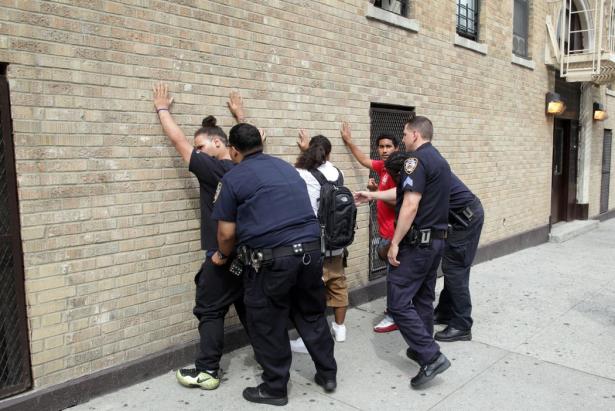The NYPD Has Stopped Tens of Thousands of People Under Mayor Adams. Just 5% Were White.
The NYPD has stopped tens of thousands of pedestrians since Mayor Eric Adams took office – claiming someone “fit a relevant description” or citing a vague reason like “other.” Just 5% of them were white, revealing racial disparities even starker than at the height of former Mayor Michael Bloomberg’s “stop and frisk” era.
These takeaways are according to new data the New York Civil Liberties Union shared with Gothamist. They come as the city re-examines the difficult legacy of stop and frisk a decade after a federal judge ruled that its application by Bloomberg's police department was unconstitutional. The rate of the stops dropped dramatically in Bloomberg's last year and even further under former Mayor Bill de Blasio, who campaigned on the issue.
But Adams, a former cop who ran on a message of public safety, said during his 2021 campaign that stop and frisk could be a useful policing tool if applied properly.
Cops are stopping dramatically fewer people than they did in the Bloomberg years. Just 1% of people stopped during stop and frisk's height in 2011 are detained now, after the 2013 federal court ruling that found the practice discriminated against New Yorkers of color. But police stops under Adams, which are at their highest point since 2015, are trending upward.
An NYPD spokesperson said the department does not direct officers to make a certain number of stops, but that police make stops "with increasing levels of precision" based on officers' observations. The anonymous spokesperson also said the police's authority to stop, question and possibly frisk an individual was "firmly established" by the U.S. Supreme Court Case Terry vs. Ohio more than 50 years ago.
The spokesperson went on to say the department has multiple layers of oversight and training, including audits, data analysis and the review of body camera footage it uses to investigate stops and takes corrective action where warranted.
The statement adds that the department carries out all of its work "without consideration of race or ethnicity."
Police officers reported stopping 8,502 pedestrians in the first half of 2023 – a dramatic drop from the stop and frisk heights of 2011 when police made nearly 700,000 pedestrian stops.
But as Gothamist previously reported, those peak numbers rival the amount of stops the police made with drivers last year, roughly 670,000. About 90% of the drivers searched or arrested were Black or Latino.
“The good news is there are definitely fewer [stops] happening, but the alarming thing is that the racial disparities and the apparent racial profiling continues,” said Chris Dunn, the NYCLU's legal director. “Many more Black and Latino people are being stopped without any justification whatsoever.”
Cops in five different commands told the Daily News in June they were being pushed to issue low level summonses, escalating neighborhood tensions with police. A federal monitor found that 24% of stops made by the NYPD Neighborhood Safety Teams last year were unconstitutional.
Patrick Hendry, president of the city’s rank-and-file police union, said City Hall and NYPD leadership are sending mixed messages – demanding more “enforcement activity” without formally changing the laws put in place to discourage stop-and-frisk tactics.
“We’re concerned that we are going to see even more rank-and-file police officers punished for carrying out policies and strategies we didn’t create,” Hendry wrote this week in an emailed statement to Gothamist.
NYPD officers are mandated to report every stop they make by filling out a form. The preset reasons range from noting that someone was “carrying a suspicious object” or doing something “indicative of a drug transaction.”
But police said they made nearly every stop this year – 92% – because someone either “fit a relevant description” or for a reason they labeled as “other.”
Of the 7,000 Black and Latino pedestrians the NYPD reported stopping this year, roughly 72% were deemed “innocent.” Meanwhile, police arrested nearly 40% of white New Yorkers they stopped.
Black and Latino people are “much less likely to get arrested because the stops are bogus from the get-go,” Dunn said. “For white people, their race is playing much less of a role and their actual suspicious behavior is playing a real role – and that produces a higher arrest rate.”
Dunn estimated that police are making two to three times as many stops as they say under Adams’ public safety strategy, but don’t document unwarranted stops that don’t result in a summons or arrest. NYPD precincts in the Bronx, Harlem, central and east Brooklyn and Midtown had the highest stop rates so far this year.
“There is nothing that indicates that increasing stops decreases crimes,” Dunn said. “To the contrary.”
Bahar Ostadan covers the NYPD and public safety. Got a tip? Email bostadan@nypublicradio.org or message Bahar on Signal at 646-740-7335.


Spread the word